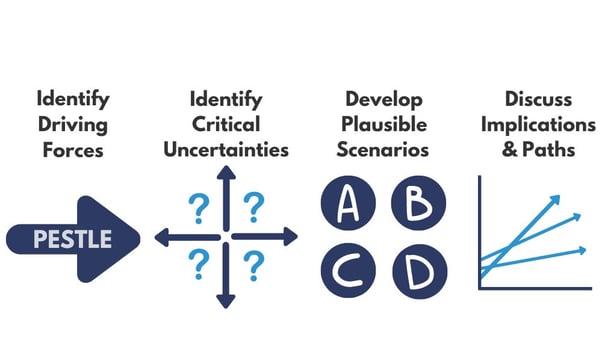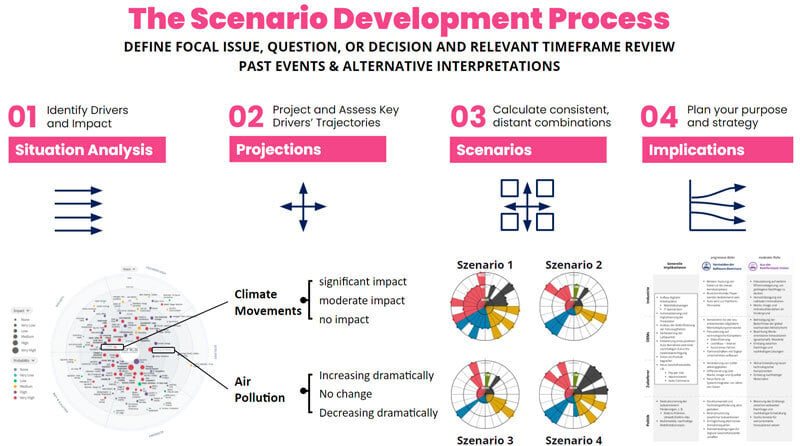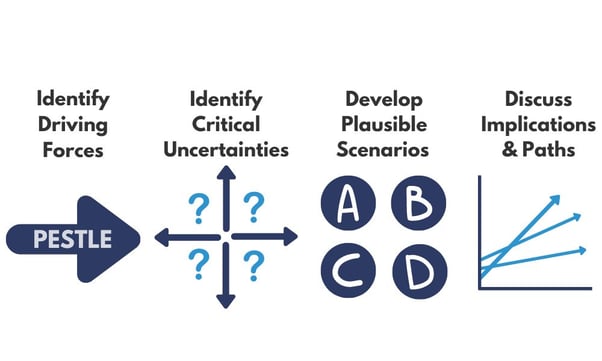Scenario Planning: A Comprehensive Guide to Future-Proofing Your Business
In an increasingly uncertain world, businesses face a multitude of challenges that can significantly impact their operations, strategies, and long-term success. Scenario planning is a strategic method that enables organizations to navigate these uncertainties by envisioning and preparing for multiple future scenarios. This article will delve into the essentials of scenario planning, its importance, and how to implement it effectively in your organization.

What is Scenario Planning?
Definition and Overview
Scenario planning is a strategic planning method that organizations use to create flexible long-term plans. Unlike traditional forecasting, which often relies on a single projection based on current trends, scenario planning involves constructing multiple, plausible future scenarios. This approach allows organizations to better understand potential risks and opportunities, enabling more informed decision-making.
Historical Context of Scenario Planning
The roots of scenario planning can be traced back to the 1960s when Royal Dutch Shell utilized the technique to navigate oil market fluctuations. Since then, it has evolved into a crucial tool for strategic planners in various industries. Organizations now adopt scenario planning to address uncertainties in areas such as technology, regulations, economic conditions, and societal changes.
The Importance of Scenario Planning
Benefits of Scenario Planning
- Enhanced Decision-Making: By considering various possible futures, organizations can make better-informed decisions that are not solely based on current trends.
- Increased Agility: Companies that engage in scenario planning can respond more swiftly to unexpected changes in the market.
- Improved Risk Management: Identifying potential risks in advance allows businesses to develop contingency plans and mitigate the impact of adverse events.
- Strategic Alignment: Scenario planning fosters alignment among team members regarding the organization’s goals and the external factors that may influence them.
Real-World Examples of Successful Scenario Planning
Many leading organizations have successfully leveraged scenario planning:
- Shell: In the 1970s, Shell used scenario planning to prepare for the oil crisis, which allowed them to make strategic decisions that ensured their survival and growth during turbulent times.
- Microsoft: The tech giant employs scenario planning to anticipate shifts in technology and consumer preferences, allowing them to stay ahead of competitors.
Key Components of Effective Scenario Planning
Identifying Key Drivers and Uncertainties
The first step in scenario planning is identifying the key drivers that will shape the future landscape of your industry. These drivers could include technological advancements, regulatory changes, economic trends, and societal shifts. Once identified, organizations should assess the uncertainties surrounding these drivers.
Developing Scenarios
Once the key drivers are established, the next step is to create plausible scenarios. These scenarios should explore various combinations of the identified uncertainties. A well-developed scenario will include detailed narratives describing how the future could unfold and the implications for the organization.
The Scenario Planning Process
Step 1: Define the Scope
To start the scenario planning process, it’s crucial to define the scope clearly. This includes determining the specific questions you want to answer, the time frame for the scenarios, and the aspects of the business you want to focus on. A well-defined scope will guide the entire scenario planning exercise.
Step 2: Identify Key Variables
Next, organizations should identify key variables that could impact their future. This may involve both quantitative and qualitative factors, such as market demand, competitive landscape, and regulatory environment. Engaging various stakeholders in this process can provide diverse perspectives and insights.

Step 3: Create Scenarios
With the key variables identified, you can now begin to create the actual scenarios. This step involves constructing detailed narratives for each scenario, illustrating how different variables interact over time. It’s important to ensure that these scenarios are distinct yet plausible. Engaging teams in workshops can foster creativity and generate comprehensive scenarios.
Step 4: Develop Action Plans
Once scenarios are developed, organizations should create actionable plans for each scenario. This includes identifying strategies to leverage opportunities and mitigate risks associated with each potential future. Action plans should remain flexible and adaptable, allowing for adjustments as new information becomes available.
Step 5: Monitor and Update Scenarios
Scenario planning is not a one-time activity; it requires continuous monitoring and updating. Regularly review the assumptions behind each scenario and adjust them based on new developments in the market. This proactive approach ensures that your organization remains prepared for any eventuality.
Tools and Techniques for Scenario Planning
To facilitate the scenario planning process, organizations can utilize various tools and techniques, including:
- Scenario Planning Software: Platforms like Scenario Generator and ITONICS offer dedicated tools for creating and analyzing scenarios.
- Workshops and Facilitated Sessions: Collaborative sessions with team members can generate valuable insights and foster buy-in for the scenario planning process.
- Scenario Analysis Frameworks: Frameworks like the PESTLE analysis (Political, Economic, Social, Technological, Legal, Environmental) can help identify external factors influencing scenarios.
By employing these tools and techniques, organizations can enhance their scenario planning efforts and improve their strategic resilience.
This content covers the first half of the article on scenario planning, detailing its definition, importance, key components, and process, along with relevant images and internal/external links. The article aims to provide a comprehensive understanding while optimizing for search engines and engaging readers.
Challenges in Scenario Planning
While scenario planning can significantly enhance strategic decision-making, it is not without challenges. Here are some common obstacles organizations may encounter:
1. Overly Complex Scenarios
Creating overly detailed or complex scenarios can lead to confusion and analysis paralysis. To avoid this, ensure that scenarios remain concise and focused on the key variables identified earlier. Aim for clarity to facilitate discussion and decision-making.
2. Resistance to Change
Organizations may face internal resistance when presenting new scenarios that challenge the status quo. To overcome this, involve diverse teams in the scenario planning process, promoting a sense of ownership and encouraging open dialogue about the potential futures.
3. Lack of Resources
Scenario planning requires time and resources, which can be challenging for smaller organizations. To address this, consider conducting shorter, focused scenario planning exercises that require less time while still providing valuable insights.
4. Failure to Act
After developing scenarios and action plans, organizations sometimes fail to implement them. Ensure that scenario planning is integrated into the broader strategic planning process, with specific responsibilities assigned to team members for monitoring and acting on the insights gained.
Frequently Asked Questions (FAQs)
What is the difference between scenario planning and forecasting?
Scenario planning focuses on exploring multiple plausible futures by considering various uncertainties, while forecasting typically predicts a single outcome based on current trends and historical data. Scenario planning encourages organizations to think flexibly and prepare for different possibilities.
How often should organizations engage in scenario planning?
Organizations should conduct scenario planning exercises regularly—ideally at least once a year or whenever significant changes in the external environment occur. This ensures that the scenarios remain relevant and actionable in the face of evolving circumstances.
Can scenario planning be applied to all types of organizations?
Yes, scenario planning is versatile and can be applied to organizations of all sizes and industries. Whether you’re in healthcare, technology, manufacturing, or non-profit sectors, scenario planning can enhance strategic resilience.
How can small businesses benefit from scenario planning?
Small businesses can use scenario planning to navigate uncertainties in their markets, helping them identify potential opportunities and risks. By planning for different scenarios, they can adapt quickly to changes and make more informed strategic decisions.

Best Practices for Implementing Scenario Planning
To maximize the effectiveness of scenario planning in your organization, consider the following best practices:
1. Involve Diverse Stakeholders
Incorporate input from various departments and levels of your organization to gain diverse perspectives. This collaborative approach can lead to richer scenarios and increased buy-in from stakeholders.
2. Use Visual Tools
Utilize visual aids, such as charts and diagrams, to represent scenarios. Visual representations can enhance understanding and facilitate discussions among team members.
3. Test Scenarios Against Current Strategies
Regularly compare the developed scenarios with existing strategies to identify potential gaps. This can help organizations adapt their strategies in response to changing external conditions.
4. Communicate Findings Clearly
Ensure that the results of scenario planning exercises are communicated effectively throughout the organization. Clarity in communication helps align teams and promotes a shared understanding of the potential futures.
5. Monitor Trends and Indicators
Continuously monitor trends and indicators that could influence your scenarios. Keeping abreast of changes allows you to adjust your scenarios and strategies accordingly.
Conclusion
In a world characterized by rapid change and uncertainty, scenario planning serves as a vital tool for organizations looking to navigate the complexities of the future. By anticipating various possibilities, businesses can prepare strategically and enhance their resilience in the face of unforeseen challenges.
Implementing a robust scenario planning process, involving diverse stakeholders, and continually refining scenarios can position your organization to thrive, regardless of what the future may hold.
For more insights on strategic planning and risk management, consider exploring this article on the SME Strategy blog or check out ITONICS for innovative solutions in scenario planning.
This completes the article on scenario planning, offering a comprehensive overview of the concept, its importance, processes, challenges, and best practices, while also optimizing for SEO with internal and external links, FAQs, and images.

